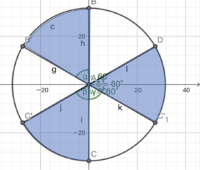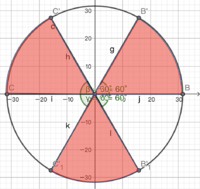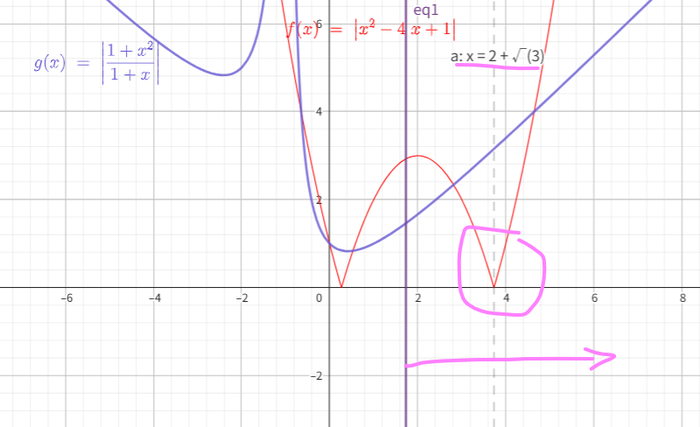Difference between revisions of "2023 AIME I Problems/Problem 15"
m (→Problem) |
(→Solution 3) |
||
| (12 intermediate revisions by 6 users not shown) | |||
| Line 14: | Line 14: | ||
<cmath>1000>p=a^2+b^2\geq 12b^2+b^2=13b^2</cmath>so <math>b^2<81</math>, and <math>b<9</math>. If <math>b=8</math>, then <math>16\sqrt 3\leq a\leq 32</math>. Note that <math>\gcd(a,b)=1</math>, and <math>a\not\equiv b\pmod 2</math>, so <math>a=29</math> or <math>31</math>. However, then <math>5\mid a^2+b^2</math>, absurd. | <cmath>1000>p=a^2+b^2\geq 12b^2+b^2=13b^2</cmath>so <math>b^2<81</math>, and <math>b<9</math>. If <math>b=8</math>, then <math>16\sqrt 3\leq a\leq 32</math>. Note that <math>\gcd(a,b)=1</math>, and <math>a\not\equiv b\pmod 2</math>, so <math>a=29</math> or <math>31</math>. However, then <math>5\mid a^2+b^2</math>, absurd. | ||
| − | If <math>b=7</math>, by similar logic, we have that <math>14\sqrt 3 <a< 28</math>, so <math> | + | If <math>b=7</math>, by similar logic, we have that <math>14\sqrt 3 <a< 28</math>, so <math>a=26</math>. However, once again, <math>5\mid a^2+b^2</math>. If <math>b=6</math>, by the same logic, <math>12\sqrt3<a<24</math>, so <math>a=23</math>, where we run into the same problem. Thus <math>b\leq 5</math> indeed. |
If <math>b=5</math>, note that | If <math>b=5</math>, note that | ||
<cmath>(a+5)(a^2+25-20a)<a^2+25\implies a<20</cmath>We note that <math>p=5^2+18^2=349</math> works. Thus, we just need to make sure that if <math>b\leq 4</math>, <math>a\leq 18</math>. But this is easy, as | <cmath>(a+5)(a^2+25-20a)<a^2+25\implies a<20</cmath>We note that <math>p=5^2+18^2=349</math> works. Thus, we just need to make sure that if <math>b\leq 4</math>, <math>a\leq 18</math>. But this is easy, as | ||
<cmath>p>(a+b)(a^2+b^2-4ab)\geq (4+18)(4^2+18^2-4\cdot 4\cdot 18)>1000</cmath>absurd. Thus, the answer is <math>\boxed{349}</math>. | <cmath>p>(a+b)(a^2+b^2-4ab)\geq (4+18)(4^2+18^2-4\cdot 4\cdot 18)>1000</cmath>absurd. Thus, the answer is <math>\boxed{349}</math>. | ||
| − | |||
==Solution 2== | ==Solution 2== | ||
| Line 47: | Line 46: | ||
</cmath> | </cmath> | ||
| − | We notice that <math>| z^3 | = p^{3/2}</math>, and <math>{\rm Re} \left( z^3 \right)</math>, <math>{\rm Im} \left( z^3 \right)</math>, and <math>| z^3 |</math> form a right triangle. Thus, <math>{\rm Re} z^3 + {\rm Im} z^3 > p^{3/2}</math>. | + | We notice that <math>| z^3 | = p^{3/2}</math>, and <math>{\rm Re} \left( z^3 \right)</math>, <math>{\rm Im} \left( z^3 \right)</math>, and <math>| z^3 |</math> form a right triangle. Thus, <math>{\rm Re} \left( z^3 \right) + {\rm Im} \left( z^3 \right) > p^{3/2}</math>. |
Because <math>p > 1</math>, <math>p^{3/2} > p</math>. | Because <math>p > 1</math>, <math>p^{3/2} > p</math>. | ||
Therefore, (3) holds. | Therefore, (3) holds. | ||
| Line 96: | Line 95: | ||
To facilitate efficient search, we apply the following criteria: | To facilitate efficient search, we apply the following criteria: | ||
| − | + | To satisfy (7) and <math>a^2 + b^2 < 1000</math>, we have <math>1 \leq b \leq 15</math>. | |
| − | |||
In the outer layer, we search for <math>b</math> in a decreasing order. | In the outer layer, we search for <math>b</math> in a decreasing order. | ||
In the inner layer, for each given <math>b</math>, we search for <math>a</math>. | In the inner layer, for each given <math>b</math>, we search for <math>a</math>. | ||
| − | + | Given <math>b</math>, we search for <math>a</math> in the range <math>\sqrt{3} b < a < \sqrt{1000 - b^2}</math>. | |
| − | + | We can prove that for <math>b \geq 9</math>, there is no feasible <math>a</math>. | |
The proof is as follows. | The proof is as follows. | ||
| Line 129: | Line 127: | ||
Therefore, we only need to consider <math>b \leq 8</math>. | Therefore, we only need to consider <math>b \leq 8</math>. | ||
| − | + | We eliminate <math>a</math> that is not relatively prime to <math>b</math>. | |
| − | + | We use the following criteria to quickly eliminate <math>a</math> that make <math>a^2 + b^2</math> a composite number. | |
* For <math>b \equiv 1 \pmod{2}</math>, we eliminate <math>a</math> satisfying <math>a \equiv 1 \pmod{2}</math>. | * For <math>b \equiv 1 \pmod{2}</math>, we eliminate <math>a</math> satisfying <math>a \equiv 1 \pmod{2}</math>. | ||
| Line 149: | Line 147: | ||
~Steven Chen (Professor Chen Education Palace, www.professorchenedu.com) | ~Steven Chen (Professor Chen Education Palace, www.professorchenedu.com) | ||
| + | |||
| + | ==Solution 3== | ||
| + | Let <math>z = a + b i (a,b\in I)</math>. <math>a^2 + b^2 = prime < 1000</math>, <math>(a,b) = 1</math>. | ||
| + | |||
| + | According to the question, <math>{\rm Re} \left( z^3 \right)</math>, <math>{\rm Im} \left( z^3 \right)</math>, and <math>|z^3|</math> construct the side-lengths of a non-degenerate triangle. | ||
| + | |||
| + | <math>z^3 = (a+bi)^3 = a^3+3a^2bi-3ab^2-b^3i = (a^3 - 3ab^2) + (3a^2b-b^3)i</math> | ||
| + | |||
| + | <math>{\rm Re} \left( z^3 \right) = a^3 - 3ab^2 > 0 => a(a^2 - 3b^2) > 0</math> | ||
| + | |||
| + | [[File:P15.png|200px]] | ||
| + | |||
| + | <math>{\rm Im} \left( z^3 \right) = a^3 - 3ab^2 > 0 => a(a^2 - 3b^2) > 0</math> | ||
| + | |||
| + | [[File:P15_2.png|200px]] | ||
| + | |||
| + | This means that the values of <math>a</math> and<math>b</math> should be limited in coincident areas these two graphs. | ||
| + | |||
| + | [[File:P15_1.png|350px]] | ||
| + | |||
| + | Also | ||
| + | |||
| + | <math>{\rm Re} \left( z^3 \right) + {\rm Im} \left( z^3 \right) > |z^3| > |z||z^2|>|z^2|</math> | ||
| + | |||
| + | <math>|{\rm Re} \left( z^3 \right) - {\rm Im} \left( z^3 \right)| < |z|^2</math> | ||
| + | |||
| + | <math>|a^3-3ab^2-(3a^2b-b^3)| < a^2+b^2</math> | ||
| + | |||
| + | <math>=|a^3-3ab^2+b^3-3a^2b|</math> | ||
| + | |||
| + | <math>=|a^3+b^3-3ab(a+b)|</math> | ||
| + | |||
| + | <math>=|a+b||a^2-4ab+b^2|<a^2+b^2 (*)</math> | ||
| + | |||
| + | If <math>a<0,b>0</math>, <math>|a^2-4ab+b^2|>|a^2+b^2|</math>, making statement <math>(*)</math> false. | ||
| + | Combining with the former graph depicting possible ranges of <math>a,b</math>, by loss of generality, we assume <math>a,b</math> both <math>>0</math> and exists in the first <math>30^{\circ}</math> of the circle. | ||
| + | |||
| + | Let <math>\frac{a}{b} = \lambda > \sqrt{3}</math>. | ||
| + | |||
| + | <math>(*) |b^3(1+\lambda)\cdot({\lambda}^{2}-4\lambda+1)| < b^2(1+{\lambda}^{2})</math> | ||
| + | |||
| + | <math>b<|\frac{1+{\lambda}^2}{1+\lambda}|\cdot|\frac{1}{{\lambda}^{2}-4\lambda+1}|</math> | ||
| + | |||
| + | To clearly visualize, we graph out <math>|\frac{1+{\lambda}^2}{1+\lambda}|</math> and <math>|{\lambda}^{2}-4\lambda+1|</math> separately. | ||
| + | |||
| + | [[File:P15_full.png|700px]] | ||
| + | |||
| + | When <math>\lambda</math> is around <math>2+\sqrt{3}</math>, b reaches its maximum upper bound. | ||
| + | |||
| + | <math>b^2(1+{\lambda}^{2}) < 1000</math> | ||
| + | |||
| + | <math>b^2<66</math> | ||
| + | |||
| + | <math>b\le 8</math> | ||
| + | |||
| + | Testing values of <math>b</math> in decreasing order, starting from 8, we test out each corresponding value of <math>a</math>(<math>b\cdot\lambda</math>)by trying the two whole numbers closest to the real value of <math>a</math>. | ||
| + | |||
| + | We finally get that <math>b=5, a=18</math> and <math>p = 5^2+18^2 = \boxed{349}</math> | ||
| + | |||
| + | ~cassphe | ||
==Video Solution== | ==Video Solution== | ||
Latest revision as of 06:47, 3 June 2025
Contents
Problem
Find the largest prime number ![]() for which there exists a complex number
for which there exists a complex number ![]() satisfying
satisfying
- the real and imaginary part of
 are both integers;
are both integers;  and
and- there exists a triangle whose three side lengths are
 the real part of
the real part of  and the imaginary part of
and the imaginary part of 
Solution
Assume that ![]() . Then,
. Then,
![]() Note that by the Triangle Inequality,
Note that by the Triangle Inequality,
![]() Thus, we know
Thus, we know
![]() Without loss of generality, assume
Without loss of generality, assume ![]() (as otherwise, consider
(as otherwise, consider ![]() ). If
). If ![]() , then
, then
![]() `Thus, this means
`Thus, this means ![]() or
or ![]() . Also note that the roots of
. Also note that the roots of ![]() are
are ![]() , so thus if
, so thus if ![]() ,
,
![]() Note that
Note that
![]() so
so ![]() , and
, and ![]() . If
. If ![]() , then
, then ![]() . Note that
. Note that ![]() , and
, and ![]() , so
, so ![]() or
or ![]() . However, then
. However, then ![]() , absurd.
, absurd.
If ![]() , by similar logic, we have that
, by similar logic, we have that ![]() , so
, so ![]() . However, once again,
. However, once again, ![]() . If
. If ![]() , by the same logic,
, by the same logic, ![]() , so
, so ![]() , where we run into the same problem. Thus
, where we run into the same problem. Thus ![]() indeed.
indeed.
If ![]() , note that
, note that
![]() We note that
We note that ![]() works. Thus, we just need to make sure that if
works. Thus, we just need to make sure that if ![]() ,
, ![]() . But this is easy, as
. But this is easy, as
![]() absurd. Thus, the answer is
absurd. Thus, the answer is ![]() .
.
Solution 2
Denote ![]() . Thus,
. Thus, ![]() .
.
Thus,
![]()
Because ![]() ,
, ![]() ,
, ![]() are three sides of a triangle, we have
are three sides of a triangle, we have ![]() and
and ![]() .
Thus,
.
Thus,
![]()
Because ![]() ,
, ![]() ,
, ![]() are three sides of a triangle, we have the following triangle inequalities:
are three sides of a triangle, we have the following triangle inequalities:

We notice that ![]() , and
, and ![]() ,
, ![]() , and
, and ![]() form a right triangle. Thus,
form a right triangle. Thus, ![]() .
Because
.
Because ![]() ,
, ![]() .
Therefore, (3) holds.
.
Therefore, (3) holds.
Conditions (4) and (5) can be written in the joint form as
![]()
We have
![]() and
and ![]() .
.
Thus, (5) can be written as
![]()
Therefore, we need to jointly solve (1), (2), (6).
From (1) and (2), we have either ![]() , or
, or ![]() .
In (6), by symmetry, without loss of generality, we assume
.
In (6), by symmetry, without loss of generality, we assume ![]() .
.
Thus, (1) and (2) are reduced to
![]()
Let ![]() . Plugging this into (6), we get
. Plugging this into (6), we get
![]()
Because ![]() is a prime,
is a prime, ![]() and
and ![]() are relatively prime.
are relatively prime.
Therefore, we can use (7), (8), ![]() , and
, and ![]() and
and ![]() are relatively prime to solve the problem.
are relatively prime to solve the problem.
To facilitate efficient search, we apply the following criteria:
To satisfy (7) and ![]() , we have
, we have ![]() .
In the outer layer, we search for
.
In the outer layer, we search for ![]() in a decreasing order.
In the inner layer, for each given
in a decreasing order.
In the inner layer, for each given ![]() , we search for
, we search for ![]() .
Given
.
Given ![]() , we search for
, we search for ![]() in the range
in the range ![]() .
We can prove that for
.
We can prove that for ![]() , there is no feasible
, there is no feasible ![]() .
The proof is as follows.
.
The proof is as follows.
For ![]() , to satisfy
, to satisfy ![]() , we have
, we have ![]() .
Thus,
.
Thus, ![]() .
Thus, the R.H.S. of (8) has the following upper bound
.
Thus, the R.H.S. of (8) has the following upper bound

Hence, to satisfy (8), a necessary condition is
![]()
However, this cannot be satisfied for ![]() .
Therefore, there is no feasible solution for
.
Therefore, there is no feasible solution for ![]() .
Therefore, we only need to consider
.
Therefore, we only need to consider ![]() .
.
We eliminate ![]() that is not relatively prime to
that is not relatively prime to ![]() .
.
We use the following criteria to quickly eliminate ![]() that make
that make ![]() a composite number.
a composite number.
- For
 , we eliminate
, we eliminate  satisfying
satisfying  .
.
- For
 (resp.
(resp.  ), we eliminate
), we eliminate  satisfying
satisfying  (resp.
(resp.  ).
).
\item For the remaining ![]() , check whether (8) and the condition that
, check whether (8) and the condition that ![]() is prime are both satisfied.
is prime are both satisfied.
The first feasible solution is ![]() and
and ![]() .
Thus,
.
Thus, ![]() .
.
\item For the remaining search, given ![]() , we only search for
, we only search for ![]() .
.
Following the above search criteria, we find the final answer as ![]() and
and ![]() .
Thus, the largest prime
.
Thus, the largest prime ![]() is
is ![]() .
.
~Steven Chen (Professor Chen Education Palace, www.professorchenedu.com)
Solution 3
Let ![]() .
. ![]() ,
, ![]() .
.
According to the question, ![]() ,
, ![]() , and
, and ![]() construct the side-lengths of a non-degenerate triangle.
construct the side-lengths of a non-degenerate triangle.
![]()
![]()
![]()
This means that the values of ![]() and
and![]() should be limited in coincident areas these two graphs.
should be limited in coincident areas these two graphs.
Also
![]()
![]()
![]()
![]()
![]()
![]()
If ![]() ,
, ![]() , making statement
, making statement ![]() false.
Combining with the former graph depicting possible ranges of
false.
Combining with the former graph depicting possible ranges of ![]() , by loss of generality, we assume
, by loss of generality, we assume ![]() both
both ![]() and exists in the first
and exists in the first ![]() of the circle.
of the circle.
Let ![]() .
.
![]()
![]()
To clearly visualize, we graph out ![]() and
and ![]() separately.
separately.
When ![]() is around
is around ![]() , b reaches its maximum upper bound.
, b reaches its maximum upper bound.
![]()
![]()
![]()
Testing values of ![]() in decreasing order, starting from 8, we test out each corresponding value of
in decreasing order, starting from 8, we test out each corresponding value of ![]() (
(![]() )by trying the two whole numbers closest to the real value of
)by trying the two whole numbers closest to the real value of ![]() .
.
We finally get that ![]() and
and ![]()
~cassphe
Video Solution
~Steven Chen (Professor Chen Education Palace, www.professorchenedu.com)
Video Solution
~MathProblemSolvingSkills.com
Animated Video Solution
~Star League (https://starleague.us)
See also
| 2023 AIME I (Problems • Answer Key • Resources) | ||
| Preceded by Problem 14 |
Followed by Last Problem | |
| 1 • 2 • 3 • 4 • 5 • 6 • 7 • 8 • 9 • 10 • 11 • 12 • 13 • 14 • 15 | ||
| All AIME Problems and Solutions | ||
These problems are copyrighted © by the Mathematical Association of America, as part of the American Mathematics Competitions. ![]()













